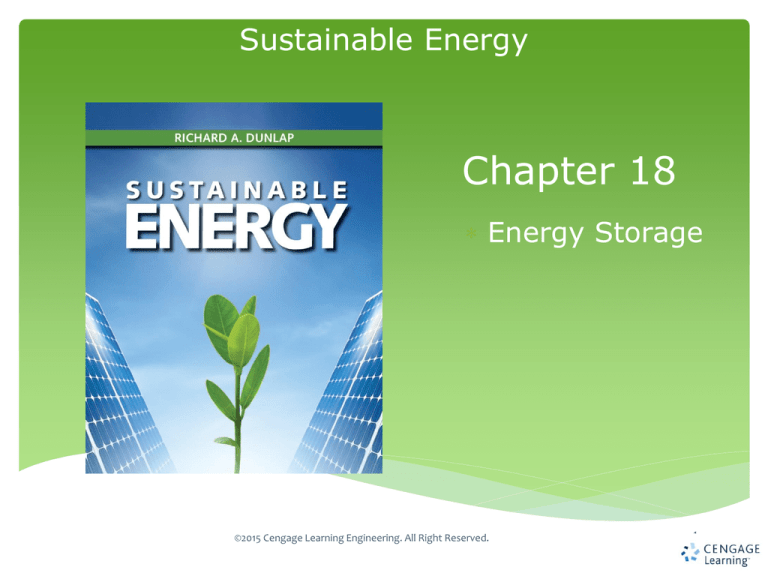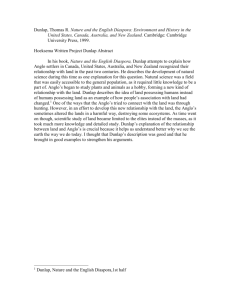
Sustainable Energy
Chapter 18
Energy Storage
©2015 Cengage Learning Engineering. All Right Reserved.
1
Sustainable Energy
Dunlap
Learning Objectives
●
●
●
●
●
●
The need for energy storage.
Pumped hydroelectric storage and its use.
The properties of compressed air.
The use of compressed air for energy storage.
Energy storage capabilities of flywheels and the
relevance of materials properties.
Properties of superconductors and the history of
their development.
©2015 Cengage Learning Engineering. All Right Reserved.
2
Sustainable Energy
Dunlap
Energy storage
Energy storage is necessary because energy is
not always produced
• when it is needed
• where it is needed
This is particularly true for many alternative
sources of energy.
©2015 Cengage Learning Engineering. All Right Reserved.
3
Sustainable Energy
Dunlap
Types of energy storage
• Residential thermal energy storage (covered in
Chapter 8)
• Batteries (covered in Chapter 19)
• Hydrogen (covered in Chapter 20)
• Other large scale electricity storage methods
(covered in this chapter)
©2015 Cengage Learning Engineering. All Right Reserved.
4
Sustainable Energy
Dunlap
Supply and demand
Typical electricity demand throughout the week showing
periods of storage during low demand and periods of stored
energy use during peak demand
©2015 Cengage Learning Engineering. All Right Reserved.
5
Sustainable Energy
Dunlap
Methods of energy storage
•
•
•
•
Pumped hydroelectric
Compressed air
Flywheels
Superconducting Magnetic Energy Storage
(SMES)
©2015 Cengage Learning Engineering. All Right Reserved.
6
Sustainable Energy
Dunlap
Pumped hydroelectric storage
Water is pumped to an elevated reservoir
during periods of low demand using excess
electricity and electricity is generated from the
potential energy of the water during periods of
high demand.
©2015 Cengage Learning Engineering. All Right Reserved.
7
Sustainable Energy
Dunlap
Analysis of pumped hydroelectric power
Potential energy of water in reservoir is
Power generated in terms of flow rate, dV/dt,
It is preferable to have high head and low flow rate
(rather than vice versa) because this minimizes the size of
the penstock and maximizes the energy per unit mass of
water.
©2015 Cengage Learning Engineering. All Right Reserved.
8
Sustainable Energy
Dunlap
Schematic of pumped hydroelectric facility
©2015 Cengage Learning Engineering. All Right Reserved.
9
Sustainable Energy
Dunlap
Use of pumped hydroelectric power
Most common method of storing large amounts of
electrical energy for the grid
Does not have to be associated with traditional
hydroelectric generation.
Ideal for storage for variable alternative
technologies
Largest facility is in Bath County, VA
Maximum capacity 2772 MWe for up to 11 hours
©2015 Cengage Learning Engineering. All Right Reserved.
10
Sustainable Energy
Dunlap
Advantages of pumped hydroelectric power
Advantages
•
•
•
•
•
•
Large capacity
High efficiency (about 80% overall)
Reliable technology
Low maintenance
Quick response to demand
Long storage time
Disadvantages
• High infrastructure cost
• Appropriate geography required
©2015 Cengage Learning Engineering. All Right Reserved.
11
Sustainable Energy
Dunlap
Compressed air energy storage
Excess electricity can be used to run pumps to
compress air during low demand periods and
the compressed air can be used to run turbines
to generate electricity during high demand
periods.
©2015 Cengage Learning Engineering. All Right Reserved.
12
Sustainable Energy
Dunlap
Analysis of compressed air energy storage
Energy available in compressed air for initial and final
pressures Pi and Pf,
Approximate energy per unit volume in kJ/m3 is
©2015 Cengage Learning Engineering. All Right Reserved.
13
Sustainable Energy
Dunlap
Requirements for
compressed air energy storage
Requires a large container of chamber
capable of withstanding high pressure
Most practical containers are underground
caverns such as former salt mines
©2015 Cengage Learning Engineering. All Right Reserved.
14
Sustainable Energy
Dunlap
Schematic of compressed air facility
©2015 Cengage Learning Engineering. All Right Reserved.
15
Sustainable Energy
Dunlap
Compressed air energy storage facilities
Two major facilities exist worldwide
• Huntorf, Germany 290 MWe capacity
• McIntosh, Alabama 110 MWe capacity
©2015 Cengage Learning Engineering. All Right Reserved.
16
Sustainable Energy
Dunlap
Huntorf compressed air facility
©2015 Cengage Learning Engineering. All Right Reserved.
17
Sustainable Energy
Dunlap
Flywheels
Rotating objects have energy associated with their
rotational motion
where I is the moment of inertia and ω is the angular
frequency.
Stored energy can be maximized if I is large and/or if ω is
large.
©2015 Cengage Learning Engineering. All Right Reserved.
18
Sustainable Energy
Dunlap
Moment of inertia
The moment of inertia of an object depends on its mass,
its dimensions and its geometry. For a cylindrically
symmetric object
The constant k for some simple geometries is shown.
©2015 Cengage Learning Engineering. All Right Reserved.
19
Sustainable Energy
Dunlap
Example of flywheel energy
A disk of steel with a diameter of 0.85 m and a mass of
400 kg rotates at an angular frequency of 40 s-1.
This is a good description of a wheel on a freight train
traveling at 100 km/h.
The rotational energy content of this disk is sufficient to
light a 60 W light bulb for about an hour.
Storing a reasonable amount of energy would require a
very large flywheel rotating at a very high frequency.
©2015 Cengage Learning Engineering. All Right Reserved.
20
Sustainable Energy
Dunlap
Ideal flywheel geometry
The table shows that a ring gives the best value of k and
represents a common flywheel design.
The maximum rotational frequency of a flywheel will be
limited by the strength of the flywheel material.
Practical limits for a flywheel energy storage capacity is
probably in the range of 100 kWh, much less than
pumped hydroelectric or compressed air.
©2015 Cengage Learning Engineering. All Right Reserved.
21
Sustainable Energy
Dunlap
Characteristics of flywheel energy storage
Advantages
• Compact
• Efficient
Disadvantages
• Minimal capacity
• Losses due to friction (~1% per hour)
Potential uses
• Short term backup to even out power fluctuations due
to variability of alternative energy sources
©2015 Cengage Learning Engineering. All Right Reserved.
22
Sustainable Energy
Dunlap
Superconducting Magnetic Energy Storage
(SMES)
Electric current can circulate indefinitely in a
superconducting coil without loss.
Electrical energy can be stored by injecting
current into the superconducting coil and
extracting it as needed.
©2015 Cengage Learning Engineering. All Right Reserved.
23
Sustainable Energy
Dunlap
Energy storage in a coil
The energy stored in a current circulating in a coil is
The inductance of the coil is
where the geometry factor f is
©2015 Cengage Learning Engineering. All Right Reserved.
24
Sustainable Energy
Dunlap
Superconductivity and magnetism
The superconductivity of a material can be destroyed by
temperature or a magnetic field.
Type I superconductors undergo a transition from the
superconducting to the normal state as a function of
temperature and magnetic field.
Type II superconductors undergo a transition from the
superconducting state to a mixed state and then to a normal
state.
Magnetic field can result from current flowing through
superconductor.
©2015 Cengage Learning Engineering. All Right Reserved.
25
Sustainable Energy
Dunlap
Critical temperatures and fields for
Type I and type II superconductors
©2015 Cengage Learning Engineering. All Right Reserved.
26
Sustainable Energy
Dunlap
High temperature superconductors
First discovered in 1986, critical temperature has increased
since then
©2015 Cengage Learning Engineering. All Right Reserved.
27
Sustainable Energy
Dunlap
Critical properties of some superconductors
High temperature superconductors have high critical
temperature and critical field
©2015 Cengage Learning Engineering. All Right Reserved.
28
Sustainable Energy
Dunlap
Prototype SMES systems
Have found applications for grid stabilization
©2015 Cengage Learning Engineering. All Right Reserved.
29
Sustainable Energy
Dunlap
Summary
• Energy storage is important to satisfy grid demand
fluctuations
• Pumped hydroelectric is the most commonly used method
for large scale grid storage
• Compressed air energy storage is also a viable technique
that has been utilized
• Flywheels can store energy, but on a smaller scale than
pumped hydroelectric or compressed air
• Flywheels are most applicable for stabilizing short term
grid fluctuations
• A superconducting current can store energy
• High critical temperatures and high critical magnetic fields
are desirable characteristics of a superconductor for
energy storage
• SMES has found applications for grid stabilization
©2015 Cengage Learning Engineering. All Right Reserved.
30



